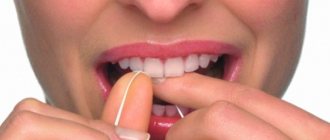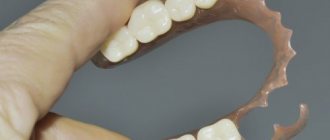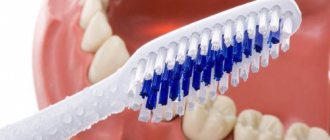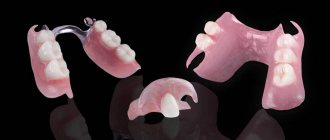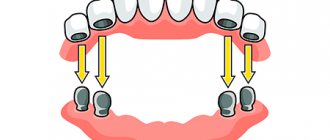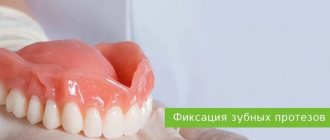July 15, 2019
Dentures are a solution for those who do not want to go without teeth. And if a decade ago people believed that when restoration of defects with removable devices old age would inevitably approach them, today such a misconception can be avoided: in modern dentistry you can be offered light and compact designs that allow you to chew without pain and with comfort, to feel good and boldly smile at others. For example, the most comfortable models for the upper teeth are created without the palate. What are these designs and how do they differ from traditional ones? What are they? Read the editorial material of the UltraSmile.ru portal and find out the details!
Features and disadvantages of traditional removable dentures with palate
Palate dentures are classic removable structures made of acrylic, nylon or polyurethane designed for the upper jaw. They are also called covering ones, because. they typically restore a large number or full row of teeth. However, if only a few teeth need to be restored, then structures of this type also have an overlap, i.e. they are quite massive and their main feature and disadvantage is the palatal bridge, which greatly overlaps the palate.
The photo shows a prosthesis with palate closure
The bridge is created so that the devices are better held in the mouth, adhere more tightly to the mucous and soft tissues and do not move horizontally. However, this feature ultimately turns into a real tragedy for patients: it becomes impossible to taste their favorite foods and drinks due to the fact that the prosthesis blocks about 40% of all taste buds, which are located on the palate. As a result, about 70% of patients with this problem lose the opportunity to eat properly.
Complete blocking of the sensitive palate leads to other serious problems:
- constant irritation of receptors causes increased salivation,
- some patients, even after months of adaptation, cannot get rid of the gag reflex,
- diction is impaired - articulation and sound pronunciation,
- the mucous membrane under the structure can periodically become inflamed from friction, which is why patients with “retractors” often experience stomatitis1,
- a person is constantly haunted by the feeling of a foreign body in the mouth,
- a long period of adaptation: you have to revise your diet, and also get used to changing the position of the tongue, because the palatal part becomes lower.
Many patients find it quite problematic to get used to traditional dentures with a palate.
Advantages
An undoubted advantage is the aesthetic appearance, better than that of acrylic and clasp structures. And:
- light weight, which is a significant factor for the upper jaw, where a person feels every gram of a foreign body;
- small basis. There is no wide part blocking the sky, like the plate analogue, which is much more comfortable;
- quick addiction is due to the two points above;
- “invisible prosthesis”, invisible to others, a person can laugh and talk without hesitation. Nylon, in this sense, is a good material; it perfectly imitates gums. And since the clasps are a continuation of the base and are of the same color, they are attached directly to the gums behind the supporting tooth, so they are not visible. What is an advantage over metal visible hooks of clasp structures and acrylic ones;
- hypoallergenic. The production does not use toxic monomers that are added to the plastic mass of acrylic prostheses. They are the ones who cause allergies in patients. By the way, other alternatives to prosthetics have appeared for such sensitive people - Acry Free;
- there is no metallic taste in the mouth due to the absence of metal in the composition;
- The next plus will be felt by people who have a small mouth. Opening it wide to install a large prosthesis is not very comfortable. But not in this case. Nylon bends easily and does not require such sacrifices from patients.
Flaws
It cannot be said that all the disadvantages that we describe below apply to mini-prostheses. They are the ones who receive the least number of complaints. But larger designs definitely have the following negative nuances:
- uneven load when chewing and discomfort when chewing food. The base is flexible and when bitten it bends even more, all the pressure goes to one area, which causes pain. Since the load is not distributed over the entire prosthetic bed, the tissues underneath it atrophy;
- rapid atrophy. Under any removable denture this process occurs and the height of the alveolar ridge is lost. You can find figures about 1mm per year. Loss of tissue leads to subsidence of the prosthesis;
- damage to the gums in the area of clamp fixation. Unlike the clasp type and the plate type, where the hooks wrap around the neck of the supporting tooth, nylon dentures have a gingival attachment. Therefore, the load when chewing is transferred not to the tooth, but to the gum, which over time injures it;
- a fairly rapid decline in aesthetics. Nylon scratches, becomes sticky over time, and attracts dirt;
- beyond repair;
- short service life - up to 5 years and at the same time the need for frequent corrections.
Design features of devices without a sky and their advantages
They are lighter and more compact; they are also called new generation prostheses due to their increased level of comfort. Designed to restore teeth in the upper jaw. Unlike traditional ones, they do not have a massive palatal overlap, however, removable types still have a small arch or bar on top, which helps them to be held securely in the mouth and not move. If we talk about prostheses on implants, then this is the option when the patient’s palate remains completely open.
The advantages here are obvious: a quick and more comfortable period of adaptation to new teeth, greater naturalness and naturalness of artificial structures, and the absence of serious problems with diction. And most importantly, the opportunity to feel the taste of your favorite dishes.
Dentures without a palate are more comfortable to adapt to and use
Newest dentures without palate
According to studies conducted among hundreds of people who use traditional dentures, approximately 70% of respondents cannot eat properly and more than 30% suffer from inflammation in the oral cavity. It has also been proven that the use of structures that cover the palate leads to blocking up to 40% of taste buds, that is, the patient cannot fully enjoy the taste of food.
To avoid such unpleasant restrictions, a new generation of removable dentures - without a palate - was developed. These are special designs with a reduced base, the peculiarity of which is that the palate remains open while the structure is worn, and the load on the jaw is distributed more evenly than with classic products.
Types of structures without sky
All varieties can be divided into three large groups: completely removable, conditionally removable with support on living teeth, or non-removable.
- removable ones, due to their design features, have a reduced palatal overlap. This group includes clasp structures and their more advanced analogues “Quadrotti”,
- conditionally removable ones can be fixed with clasps or can be “put on” over the remaining teeth (sandwich dentures), if any remain. Such prostheses do not need to be removed too often, but this possibility remains - that is why they are called “conditionally removable”
- non-removable - these are prostheses that will be fixed on implants - these do not cover the palate at all. They are securely held and can restore either part or all of the teeth.
Which ones are better to choose? It all depends on the clinical situation, the number of missing teeth, the condition of the jaw bone tissue, the preferences and financial capabilities of the patient. We propose to consider each type in more detail.
Price
A removable sandwich denture is not a cheap pleasure. But you need to understand that the operational and aesthetic properties of the device are worth it. When talking or smiling, the attention of the interlocutor is always drawn to the front teeth, so they should look presentable, be it their teeth, veneers, implants or dentures.
Post-procedure check-up
To create the structure, durable and high-quality Italian or German materials are used, which make it as natural as possible . The soft part has a natural pink tint that matches the color of the gums. If you don’t know that the patient has a prosthesis installed, no one will ever guess about it.
The weight of the structure reaches only 6-8 grams, which is half the weight of a regular toothbrush.
The cost of installation consists of several parameters. The price depends on the region, the pricing policy of the clinic, as well as the scale of preparatory procedures. That is, for example, if a patient has retained several of his own healthy teeth and no preliminary treatment is required, he will only have to pay for basic services:
- the work of a specialist (regulated by the price list of the selected dentistry);
- prosthesis comfort test;
- taking a photo;
- creating a cast;
- production of prosthesis;
- fitting of the design;
- design correction (if required);
- final installation.
If you don’t have your own teeth or need treatment with implants, the final cost will increase. Additionally, professional oral hygiene and x-rays may be needed. For all services, including the price of the prosthesis itself, you can pay about 100 thousand rubles for one jaw.
An individual sandwich prosthesis for one jaw costs, on average, 45 thousand rubles.
Clasp systems
Clasp designs are truly unique dentures. They were invented by German scientists back in the 19th century. But despite the vast practice in their use, the devices are not outdated and are still considered one of the most popular in the treatment of edentulism. They can even be used, taking into account the latest trends, as new generation prostheses (attached using a telescopic connection or using locks).
A classic clasp denture consists of a metal base, acrylic gum, artificial crowns and hooks. In order for it to be securely held in the mouth, it needs support in the form of remaining teeth, so using a clasp cannot solve the problem of complete adentia.
The prosthesis consists of a metal base, acrylic gum, artificial crowns and hooks
It cannot be said that such a device will be made completely without the sky. Its structure contains a small metal arc, which you can even touch with your tongue if you wish, but, as most patients note, this feature does not interfere with the perception of the taste of food and does not affect diction.
The great advantage of clasps is that in addition to restoring the dentition, they are used in the complex treatment of diseases such as periodontitis and periodontal disease. They are practically incurable in an advanced stage, but many patients still do not agree to part with their diseased and loose teeth immediately, and splinting clasp removable dentures for the upper or lower jaw help prevent their loss or at least delay this moment, normalizing the chewing function.
Despite the fact that clasp dentures are considered removable, they are not so easy to pull out of the mouth; they literally cling to the supporting teeth with hooks, so the risk of them falling out is minimized. And if you also secure them in a more reliable way, as required by the trends of the new generation, on locks or telescopic crowns, then they can generally be called conditionally removable. The fastening is so reliable that only a doctor can remove the structure.
What’s also nice is that the clasp, that is, the metal component, allows a person to chew food quite comfortably, evenly distributing the load between diseased and healthy teeth, without causing injury or premature loss. This eliminates the risk of deformation of the prosthesis. They serve for about 7-10 years. Well, plus everything, the devices are practically without a sky, which means their operation is quite convenient for patients. Reviews confirm this.
Clasp appliances are attached to the abutment teeth using hooks
“I have a removable upper denture with a clasp, it is on hooks, and, thank God, without this terrible palate (there is only a small arch, which is not critical). I have been wearing it for several years because I suffer from periodontitis. So far I’m happy with everything, I don’t have any allergies to metal. The periodontist suggested removing the diseased teeth and installing a complete removable denture on the upper jaw, on suction cups, or doing basal implantation. The first is too old-fashioned and impractical for me, the second is still very expensive, but I will save up to improve my life even more significantly.” Kirill Novin, from a review from otzovik.com
As patients and orthopedists note, the disadvantages of such devices include relatively long addiction. And the metal component (hooks) can be noticeable on the front teeth, rub the mucous membrane in especially sensitive people and cause irritation, an abundance of saliva, and the appearance of a metallic taste in the mouth in allergy sufferers and those suffering from galvanic syndrome.
Microprosthetics
This is the restoration of tooth structure using inlays (internal or cavity dentures) and onlays (full or partial veneers). Microprosthetics is a promising direction in the development of aesthetic and orthopedic dentistry. Microprosthetics refers to the concept of “dental restoration,” which implies the restoration of a partially destroyed tooth.
Evolution is taking place in prosthetic dentistry, primarily due to the emergence of new materials and treatment methods. If in the past they used rubber and a ceramic tooth embedded in it to create a removable denture, today they use composite materials, biologically neutral metal alloys, and modern methods of tooth root implantation.
Modern technologies and modern materials allow the orthopedic surgeon to achieve the most natural smile for the patient. Today, the fashion for a healthy, most natural smile is supported by modern possibilities in dentistry, and this must be taken advantage of.
Quattro Ti
If you are interested in the new generation of removable dentures without a palate (Quattro Ti has only a small thin palatal plate with holes, which causes virtually no discomfort), then be sure to pay attention to Quadrotti. They are similar to clasp devices in their operating principle; they also compensate for the loss of one, several, or a large number of teeth in any jaw, and are used for periodontal inflammation. But they have several advantages, due to which they compare favorably with classic clasps: they are made of soft plastics and are more comfortable, they can be used to restore even a completely toothless jaw, they are suitable for people involved in dangerous sports and for allergy sufferers, for patients of any age . The newest Quattro Ti palateless dentures are soft but have a very dense metal-free base.
“Quadrotti” dentures without a palate do not have a metal component, so the process of getting used to them is faster, and there will be no side effects in the form of corrosion or toxic effects on the body. What’s also nice is that the elastic material from which the hooks for fastening are made can be of any shade in this prosthesis, from soft pink and white to transparent. It fits perfectly to the teeth and gums, so it will look unnoticeable and very aesthetically pleasing even in the smile area.
Another advantage is that these modern removable dentures are significantly smaller in size than similar models, they have a minimum of artificial gum, and they are practically without a palate. You can clearly see this in the photo below. This means that your false upper or lower jaw will be practically imperceptible during use, which, by the way, is very impressive - more than 7 years.
The photo shows Quattro Ti prostheses
“I have been wearing an upper denture without a palate recently. It is made in Italy and is quite comfortable. Of course, I realize that a denture for the upper jaw, even of such excellent quality, is worse than implantation. Still, we must admit that it is not without the shortcomings of all removable systems, although they are leveled out here. Therefore, I am planning to start restoring my teeth in the near future. The doctor calculated the cost of the complex for me, when supposedly in 3 days I would get a new smile, it’s called all-on-4. After this, a non-removable lightweight prosthesis will be installed, and after six months it will be replaced with a permanent one, which will last, perhaps for the rest of my life, if I take care of it. Sounds very tempting! So I’m looking forward to the transformation.” NataK, review from the dental portal gidpozubam.ru
Specifics of modern prosthetics
The choice of prosthesis for each case is individual. However, there are common characteristics associated with tooth restoration in the upper and lower jaw.
For example, in the lower jaw the bone tissue is denser, which ensures reliable fastening and high stability of the prosthesis. In addition, the lower jaw bone is larger than the upper. However, the presence of a frenulum in the design can cause discomfort when worn and a slight displacement of the prosthesis in the oral cavity.
Fixing the product to the upper jaw is a little easier. The presence of the palate provides enough space for attaching a denture, and the chewing load is not as intense as on the lower jaw. However, the upper part is subject to increased aesthetic requirements. After all, the top front row almost completely falls into the smile zone.
Sandwich prosthesis
As an alternative to clasp and Quattro Ti, you can also consider the “sandwich”, patented only in 2014 by Russian scientists. It belongs to the new generation devices, without sky. It is soft, attached to the remaining chewing teeth (at least 2 units on each side of the jaw) using rigid fixing crowns according to the telescope principle (hollow side crowns are put on top of them, like caps). The patient who will wear such a device does not need to grind the supporting teeth in preparation for prosthetics. There is also no need to remove the device from your mouth every day, which is why it is also called conditionally removable.
A sandwich denture is attached on top of the remaining teeth
Suitable for bruxism and epilepsy, indicated for those patients who, for some reason, are not suitable for other designs. However, for those who have inflammatory processes in the mouth, periodontitis and periodontal disease, wearing a “sandwich” is contraindicated.
Indications for installation
Indications for removable nylon dentures can be:
- loss of one or more teeth in a row;
- scattered defect;
- absence of all teeth;
- allergy to metal, acrylic;
- if you do not want to grind the supporting teeth for dentures, for example, clasp ones with locks;
- periodontal disease of 1st and 2nd degrees to keep teeth in place (but 3.4 degrees will already be a contraindication);
- patient refusal or medical contraindications to implantation;
- childhood, if necessary, hide early tooth loss;
- as a temporary solution for implantation with delayed loading.
Sometimes nylon dentures can be installed to treat bruxism, involuntary grinding in the mouth, which damages tooth enamel and increases wear. And also for athletes and people involved in traumatic sports, a flexible design is the best option, better than acrylic, which can easily break in case of injury.
Prosthesis with locks
Such conditionally removable structures differ favorably from completely removable ones in that they do not have any palatal overlap at all. Thanks to the reliability of the locking system, this is simply not necessary. Teeth or preserved roots (at least one on each side of the jaw) can act as support for such a device. If prosthetics are carried out on the roots, then they are first strengthened with pins with rounded heads; if on crowns, then one part of the fastening is created in the abutment tooth, and the second is placed in the base of the prosthesis.
Such prostheses are secured using special locks.
This type of design is convenient, compact, and easy to use, but you will have to pay more to restore teeth in this way than for the above-listed designs.
Expert opinion
Roman Borisovich Alekperov
orthopedic dentist
Experience: 24 years
The choice of flexible prostheses is based mainly on the patient’s desire to receive maximum comfort from wearing an orthopedic structure. Nylon or silicone prostheses do not require long-term adaptation - made from an individual cast, they immediately sit comfortably and allow you to chew food and speak normally. It is important to remember that long-term wearing of flexible prostheses can lead to the development of atrophic processes in bone tissue, since these structures do not have a rigid base. Do not use flexible dentures for more than 6-9 months if you are planning to have implants. If such a situation occurs and the bone is “gone,” it will be necessary to pre-build it or perform basal implantation.
Prosthesis on implants
The options presented above are good, but not without the disadvantages of removable systems. Indeed, despite the reduced palatal overlap, they still remain removable. However, today patients can get rid of such problems by choosing implant-supported dentures that really will not block the palate and will allow you to feel as comfortable as possible.
Only an implant can provide the correct load on bone tissue; it uses it in the process of chewing food, forcing tissue cells to quickly recover. This is where qualitative changes in appearance occur: wrinkles are smoothed out, the oval of the face is restored, the skin is tightened - not a single removable denture for teeth (even without a palate) can provide such transformations.
Modern patients have a unique opportunity not only to restore any number of teeth (even with complete edentia, with a lack of bone due to prolonged wearing of dentures with or without a palate), but also to immediately get rid of other problems: for example, the fear of looking ugly and unnatural, discomfort , dietary restrictions, indigestion, the need to build bone tissue, bad breath.
The photo shows an implantation scheme on four implants
Existing methods of one-stage implantation with immediate loading, for example, “all on four” or “all on six” implants and others, allow you to get the new smile you have long dreamed of in less than a week. And fixed dentures according to such treatment protocols will be made, of course, without the palate, and at the same time they have a number of other advantages:
- you receive the prosthesis almost immediately - within the first 3-5 days after the operation to install the implants is performed,
- the design is completely non-removable and can be eaten without fear of breakage the very next day: at its base there is a strong metal component that connects the implants to each other,
- the design is light, without a palate, has a thin plastic base and is equipped with a beautiful artificial gum that covers imperfections damaged by diseases or long-term absence of teeth with natural mucosa,
- the prosthetic frame correctly stabilizes any deviation in the installation of implants, correctly distributes the load between implants, serves as a deterrent against the loss of artificial roots even in the most difficult clinical cases and eliminates the risk of their displacement under significant chewing loads,
- reliable fixation in the mouth,
- quick addiction
- the opportunity to taste your favorite dishes,
- no dietary restrictions after the rehabilitation period has passed,
- there is no need to constantly adjust such a prosthesis (unlike removable ones).
The most reliable and comfortable is a prosthesis on implants.
As you can see, there are very, very many options for quite comfortable and very comfortable prosthetics. Today, each patient will be able to choose what suits him according to cost and personal preferences.
Notice
: Undefined variable: post_id in
/home/c/ch75405/public_html/wp-content/themes/UltraSmile/single-item.php
on line
45 Notice
: Undefined variable: full in
/home/c/ch75405/public_html/wp-content /themes/UltraSmile/single-item.php
on line
46
Rate this article:
( 5 ratings, average: 3.40 out of 5)
prosthetics
- Galonsky V.G., Radkevich A.A. Reaction of the mucous membrane of the supporting tissues of the prosthetic bed to the impact of removable dentures. Siberian Medical Journal (Irkutsk), 2009.
Expert “Even the most ideal removable models last no more than 5-7 years. At the same time, not a single prosthesis that fills gaps in the dentition (we are talking about removable ones), with or without a palate, excludes atrophy of the jaw bone tissue. When thinning of the bone and subsidence of the gums occurs, the prosthesis loses the quality of fixation and constantly needs correction and relining. The situation with implants is different - they force the bone tissue to “work”, so the entire system functions as naturally and properly as possible.” Orthopedist Stanislav Vladimirovich Chorny
Consulting specialist
Sambuev Bair Sergeevich
Specialization: Orthopedic dentist Experience: 11 years
Indications and contraindications
List of indications for installation of upper removable dentures without palate:
- the presence of at least two healthy teeth or roots (supporting crowns can be placed on them, on which the prosthesis will be fixed);
- lack of bone tissue, diabetes mellitus, blood diseases, etc.;
- increased gag reflex;
- Correction of the bite during the period of change of baby teeth.
Among the limitations of using prosthetic teeth without a palate are allergies to the materials included in the structure and mental illness. In addition, it is impossible to install a removable denture without a palate in the absence of teeth.
Comments
I wear a removable denture, it has no palate, at first everything was really very comfortable, but over time I began to feel discomfort. At the moment I am collecting information on implantation and in the near future I want to decide to install implants. This solution is not cheap. Tell me, will it be possible to install my removable denture without a palate on implants for the first time in order to at least somehow save money?
Alexey Nikolaevich (07/21/2019 at 23:25) Reply to comment
- Dear Alexey Nikolaevich! Orthopedic dentists in some innovative clinics today have the opportunity to adapt removable dentures without a palate, which were made for the upper or lower jaw and were already used by the patient, for fixation on implants. This actually allows you to save a little money initially. However, this method excludes the metal component in the design, therefore it does not allow a person to begin to eat properly immediately after the installation of implants, and requires re-prosthetics in the future (about six months after the installation of the implants, when they engraft into the jaw bone tissue).
Editorial staff of the portal UltraSmile.ru (07/25/2019 at 10:04 am) Reply to comment
I was interested in where in Moscow we can actually get teeth done in 1 day by immediate implantation with a prosthetic load? It seems to me that this is all just advertising...
Editorial staff of the portal UltraSmile.ru (07/21/2019 at 23:27) Reply to comment
I was interested in where in Moscow we can actually get teeth done in 1 day by immediate implantation with a prosthetic load? It seems to me that this is all just advertising...
Vadim (08/15/2019 at 15:24) Reply to comment
- Dear Vadim! Clinics that perform express implantation in a few days actually exist today. To see this, read our article TOP 10 clinics for express implantation. Immediate implantation refers to a treatment protocol when the patient is implanted and within 2-3 days after that a permanent prosthesis is immediately placed, with which you can start chewing food. However, you need to understand that any implantation protocol is preceded by a thorough preparatory stage, which, depending on the individual characteristics of the patient, can take from 2 days to several months (for example, if there are diseases or relative contraindications are identified).
Editorial staff of the portal UltraSmile.ru (08/23/2019 at 09:07) Reply to comment
Write your comment Cancel reply
Care and storage of nylon prostheses
The products can be worn around the clock. They only need to be removed for hygiene purposes - cleaning. After eating, you should rinse with plain running water every time. At least 2 times a day, preferably at the beginning and end of the day, you should thoroughly clean off food debris using a special brush. Experts do not recommend using aggressive means.
They can be cleaned using regular soap and a brush. The service life of the medical system will be extended by using special baths and pastes for these purposes several times a week, and using antiseptic liquids purchased for these purposes at the pharmacy. Periodically, once every 2-3 months, it is advisable to bring nylon dentures to the clinic for more thorough cleaning.
However, despite the exhaustive information, only an experienced dentist can answer the question of which dental prosthetic option is best for you. A professional will competently assess the condition of the oral cavity, will certainly listen to your wishes and offer the best prosthetic option suitable for you.
Back
Stock
-47%
Dental implantation RUB 18,500.
until 01/15/2022 35,000 rub. 18500 rub.
get -9 %
BASAL COMPLEX - Restoration of teeth on 1 jaw in 3 days 330,000 rub.
300,000 rub.
get -25 %
Removable denture for 1 jaw 40,000 rub.
30,000 rub.
get -40 %
Treatment of caries with a discount of 3000 rubles.
5000 rub. 3000 rub. get
